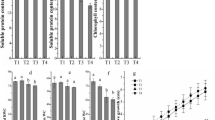Abstract
Upland and lowland rice (Oryza sativa L.) showed different mechanisms of water stress resistance. Hydroponically grown 3-week-old seedlings of a lowland variety IR64 and an upland variety were exposed to 15% polyethylene glycol (PEG-6000). After 7 d of treatment, IR64 maintained high relative water content and developed a well-branched root. Therefore, IR64 had better water-deficit tolerance than Azucena under PEG treatment. To identify water-deficit-responsive proteins associated with the tolerance differences between two ecotypes, a comparative proteomic analysis of roots was conducted. Out of 700 proteins reproducibly detected on two-dimensional electrophoresis gels, 65 proteins exhibited significant changes in at least one ecotype at 48 h of water deficit. Only 15 proteins showed different responses to water deficit between the two ecotypes. Twelve proteins were identified by matrix-assisted laser desorption/ionization-time of flight/time of flight-mass spectrometry, which involved in energy and metabolism, protein processing and degradation, detoxification and pathogenrelated (PR) proteins, i.e. PR-1a, RSOsPR10 and JIOsPR10. All three PR proteins were induced more strongly in IR64 than in Azucena by water deficit at both protein and mRNA level. The results suggested that PR-1a, RSOsPR10 and JIOsPR10 may play important roles in protecting root cells against water deficit in rice.
Similar content being viewed by others
Abbreviations
- ABA:
-
abscisic acid
- CRT:
-
C-repeat
- 2-DE:
-
two-dimensional electrophoresis
- DRE:
-
dehydration-responsive element
- JA:
-
jasmonic acid
- MALDI TOF/TOF:
-
matrix-assisted laser desorption/ionization-time of flight/time of flight
- PEG:
-
polyethylene glycol
- PR:
-
pathogen-related
- RWC:
-
relative water content
- SA:
-
salicylic acid
- SAR:
-
systemically acquired resistance
References
Choudhary M.K., Basu D., Datta A., Chakraborty N. & Chakraborty S. 2009. Dehydration-responsive nuclear proteome of rice (Oryza sativa L.) illustrates protein network, novel regulators of cellular adaptation and evolutionary perspective. Mol. Cell. Proteomics 8: 1579–1598.
Hashimoto M., Kisseleva L., Sawa S., Furukawa T., Komatsu S. & Koshiba T. 2004. A novel rice PR10 protein, RSOsPR10, specifically induced in roots by biotic and abiotic stresses, possibly via the jasmonic acid signaling pathway. Plant Cell Physiol. 45: 550–559.
Huang D., Wu W., Abrams S.R. & Cutler A.J. 2008. The relationship of drought-related gene expression in Arabidopsis thaliana to hormonal and environmental factors. J. Exp. Bot. 59: 2991–3007.
Jwa N.S., Agrawal G.K., Rakwal R., Park C.H. & Agrawal V.P. 2001. Molecular cloning and characterization of a novel jasmonate inducible pathogenesis-related class 10 protein gene, JIOsPR10, from rice (Oryza sativa L.) seedling leaves. Biochem. Biophys. Res. Commun. 286: 973–983.
Kim S., Ahn I.P., Park C., Park S.G., Park S.Y., Jwa N.S. & Lee Y.H. 2001. Molecular characterization of the cDNA encoding an acidic isoform of PR-1 protein in rice. Mol. Cells 11: 115–121.
Kim S.T., Yu S., Kang Y.H., Kim S.G., Kim J.Y., Kim S.H. & Kang K.Y. 2008. The rice pathogen-related protein 10 (JIOsPR10) is induced by abiotic and biotic stresses and exhibits ribonuclease activity. Plant Cell Rep. 27: 593–603.
Lescot M, Dehais P, Thijs G, Marchal K, Moreau Y, Van de Peer Y, Rouze P & Rombauts S. 2002. PlantCARE, a database of plant cis-acting regulatory elements and a portal to tools for in silico analysis of promoter sequences. Nucleic Acids Res. 30: 325–327.
Price A.H., Cairns J.E., Horton P., Jones H.G. & Griffiths H. 2002. Linking drought-resistance mechanisms to drought avoidance in upland rice using a QTL approach: progress and new opportunities to integrate stomatal and mesophyll responses. J. Exp. Bot. 53: 989–1004.
Rabello A.R., Guimaraes C.M., Rangel P.H., da Silva F.R., Seixas D., de Souza E., Brasileiro A.C., Spehar C.R., Ferreira M.E. & Mehta A. 2008. Identification of drought-responsive genes in roots of upland rice (Oryza sativa L). BMC Genomics 9: 485.
Riviere M.P., Marais A., Ponchet M., Willats W. & Galiana E. 2008. Silencing of acidic pathogenesis-related PR-1 genes increases extracellular β-(1→3)-glucanase activity at the onset of tobacco defence reactions. J. Exp. Bot. 59: 1225–1239
Salekdeh G.H., Siopongco J., Wade L.J., Ghareyazie B. & Bennett J. 2002. Proteomic analysis of rice leaves during drought stress and recovery. Proteomics 2: 1131–1145.
Si Y., Zhang C., Meng S. & Dane F. 2009. Gene expression changes in response to drought stress in Citrullus colocynthis. Plant Cell Rep. 28: 997–1009.
Wang H., Zhang H., Gao F., Li J. & Li Z. 2007. Comparison of gene expression between upland and lowland rice cultivars under water stress using cDNA microarray. Theor. Appl. Genet. 115: 1109–1126.
Yan S., Tang Z., Su W. & Sun W. 2005. Proteomic analysis of salt stress-responsive proteins in rice root. Proteomics 5: 235–244.
Yan S., Zhang Q., Tang Z., Su W. & Sun W. 2006. Comparative proteomic analysis provides new insights into chilling stress responses in rice. Mol. Cell. Proteomics 5: 484–496.
Yoshida S., Forno D., Cock J. & Gomez K. 1976. Laboratory Manual for Physiological Studies of Rice, 3rd Edn. International Rice Research Institute, Manila, Philippines.
Yu C.L., Yan S.P., Wang C.C., Hu H.T., Sun W.N., Yan C.Q., Chen J.P. & Yang L. 2008. Pathogenesis-related proteins in somatic hybrid rice induced by bacterial blight. Phytochemistry 69: 1989–1996.
Author information
Authors and Affiliations
Corresponding author
Rights and permissions
About this article
Cite this article
Yang, L., Su, N., Wu, M. et al. Proteomics to identify pathogenesis-related proteins in rice roots under water deficit. Biologia 66, 477–483 (2011). https://doi.org/10.2478/s11756-011-0054-x
Received:
Accepted:
Published:
Issue Date:
DOI: https://doi.org/10.2478/s11756-011-0054-x




